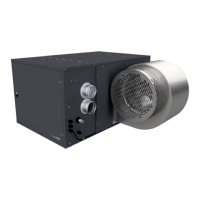page no. 20 of 68
LX Range Users, Installation & Servicing Instructions Doc Ref M110 issue 1.0 Dec 2020.
1.3.6. Related Documents
All Gas Fired heaters comply with the following European
Directives:
Gas Appliance Regulation: 2016/426EC
Electromagnetic Compatibility Directive: 2014/30/EU
Low Voltage Directive: 2014/35/EU
Machinery Directive: 2006/42/EC
Ecodesign Directive (ErP): 2009/125/EC*
Air heater(s) must be installed in accordance with BS6230
and BS5440 plus any relevant requirements of local and
national building codes. * where appropriate.
1.3.7. Gas Supply
A servicing valve and union to facilitate servicing must
be fitted to the gas inlet pipe work of the heater. The
gas supply must be completed in solid pipe work and be
adequately supported.
Minimum Supply Pressure = 17.5mbar
Maximum Supply Pressure = 25mbar
Nominal Supply Pressure = 20mbar
Any heater suspended by drop rods, straps or chains
must have a flexible connection as the final link between
the gas supply pipe work and the heater. Sufficient slack
must be left in the connection to take account of normal
movement of the heater.
WARNING: When completing the final gas
connection to a suspended heater, do not
place undue strain on the gas pipe work of
the heater.
1.3.7.1. Service Pipes
The local gas undertaking should be consulted at the
installation planning stage in order to establish the
availability of an adequate supply of gas. An existing
service pipe must not be used without prior consultation
with the local gas undertaking.
1.3.7.2. Installation Pipes
Installation pipes should be fitted in accordance with
IGEM/UP/2. Pipework from the meter to the air heater
must be of adequate size. Do not use pipes of a smaller
size than the inlet gas connection of the heater. The
complete installation must be tested for tightness as
described in the above Code.
1.3.7.1. Gas Meters
A gas meter is connected to the service pipe by the local
gas undertaking or a local gas undertaking contractor. An
existing meter should be checked, preferably by the gas
undertaking, to ensure that the meter is adequate to deal
with the total rate of gas supply required.
1.3.8. Condense
Condensation generally occurs within a flue when flue
gases are cooled to the point where they are no longer
able to hold water vapour. Instances where condensate
is likely to occur:- when a unit is on fresh air, when a unit
is operating at low fire and where a unit has a total air
volume contains more than 30% outside air. As a result,
excess water vapour condenses to form droplets of liquid.
Other relevant factors include installations where
significant length of the flue is used which may cause
chilling, or if heater may be exposed to high winds and
heavy rain, which may ingress the flue.
We recommend installing an inline condense drain flue
section when flued vertically, due to the lower flue gas
temperatures experienced when the heater is operating
at low firing rates, even if the drain point is capped, should
the drain be required in the future.
Horizontal flue runs must have a slight fall towards the
wall terminal so avoid having to be fitted with a drainage
point.
If it is considered that condensate will be formed then the
condensate drain outlet must be fitted with an external
trap, and run in suitable pipework to a legitimate point of
discharge. (refer to section 2.2.5)
NOTE: If there is any doubt as to the
requirement of connecting a drain, then one
should be connected.
* refer to current standards and legislations and localised building
regulations.
1.3.9 Ventilation Requirements
Type B flued installations.
Where heaters are installed within the heated space (ie
not in a plant room or an enclosure) and having a building
design air change rate of greater than 0.5/h, additional
provision for ventilation is not required.
If the building design air change rate is less than 0.5/h,
additional provision for natural or mechanical ventilation
is required. These being:
• Natural Ventilation:
Grilles having a free area of at least 2cm² per kW of rated
heat input shall be provided at low level i.e. below the level
of the heater flue connection.
1.3 General Requirements

